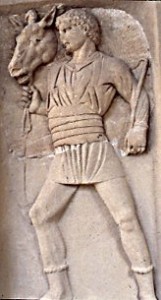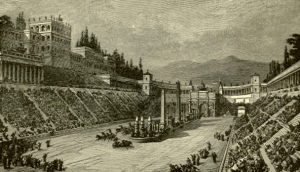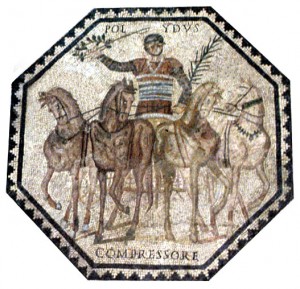Oh no! He’s taken the corner wide!
What are you doing? The next chariot is crowding you.
What are you doing, you idiot? You’re going to lose what my girl’s prayed for!
Pull, please, PULL left as hard as you can.
We are rooting for a bum.
–Ovid (43 BC – AD 17) Roman poet, Amores
This poem from circa year Zero is recognizable today. Rome was very modern, though more primal and untested, civilized thought existed then. We can feel the connection.
The idea that human nature does not change has been part of human culture since at least Aristotle’s claim that “All men by nature desire knowledge.” Repetition of historical events across cultures—revolution, poverty, despots, war—could be evidence of an unchanging basic human nature. Our ideas and knowledge have advanced, but there is a part of humanity that still shouts on the bleachers in Rome.
 Unpredictable new things have occurred in society, or at least have emerged in forms unrecognizable to that which has gone before. Such is the case of the charioteer in Ancient Rome.
Unpredictable new things have occurred in society, or at least have emerged in forms unrecognizable to that which has gone before. Such is the case of the charioteer in Ancient Rome.
Top talent on the racing circuit of antiquity attracted throngs of followers, including dignitaries and high officials, wealthy sponsors and fanatics (fans) of all levels of society. The adulation of a sports figures is familiar in our televised age, but in Rome’s day it was something new.
In earlier Greek sport, charioteers were honored along with other athletes (and poets) but Rome twisted the premise. Roman charioteers were professionals. Instead of glorifying the charioteer for achievement, Roman racing grew into a “win at all costs” spectacle that favored violent confrontation and cutthroat tactics. Ironically this escalation of conflict gave advantage to the lowest levels of society, who would take risks avoided by those of more privileged rank. (This gave no clue to the Roman elite.)
 For their part, charioteers gradually developed an impunity to societal laws and accepted conduct. The profession became synonymous with thuggery, cheating, bribery and other “low” behavior, to the point Emperor Nero “forbade the revels of the charioteers, who had long assumed a license to stroll about, and established for themselves a kind of prescriptive right to cheat and thieve, making a jest of it.” [Suetonius, “The Lives of Twelve Caesars”]
For their part, charioteers gradually developed an impunity to societal laws and accepted conduct. The profession became synonymous with thuggery, cheating, bribery and other “low” behavior, to the point Emperor Nero “forbade the revels of the charioteers, who had long assumed a license to stroll about, and established for themselves a kind of prescriptive right to cheat and thieve, making a jest of it.” [Suetonius, “The Lives of Twelve Caesars”]
Greek’s held the reins in their hands, but Roman charioteers tied them around their waists which (deliberately?) dramatically increased the danger and fatality of collisions as the pilot was subject to being dragged unless he cut his reins in time. Whether the spectacle of chariot-racing was a symptom or a cause, Roman societal attitudes became increasingly fatalistic and competitive, and finally merciless and capricious. And then … nothing.
The Greek view of awarding athletes “honor and glory” was replaced in Rome with the material rewards of fame and wealth. We don’t know the names of many Greek chariot-racing heroes; we know more about the celebrated Roman charioteers. However, while Greek racing flourished and developed into a new form, there was no second act for the Roman Circus.
 In our modern society we have celebrity athletes of different sports, but this is not simply a continuation of historical tradition. Rome was the society that first grew athlete-superstars was Rome. After their collapse, Europe endured a period of centuries known as the Dark or Middle Ages in which there were no celebrity athletes. It was not until the Industrial Age and the organization of modern sports that athletes began to again capture the popular imagination as celebrated stars.
In our modern society we have celebrity athletes of different sports, but this is not simply a continuation of historical tradition. Rome was the society that first grew athlete-superstars was Rome. After their collapse, Europe endured a period of centuries known as the Dark or Middle Ages in which there were no celebrity athletes. It was not until the Industrial Age and the organization of modern sports that athletes began to again capture the popular imagination as celebrated stars. Unpredictable new things have occurred in society, or at least have emerged in forms unrecognizable to that which has gone before. Such is the case of the charioteer in Ancient Rome.
Unpredictable new things have occurred in society, or at least have emerged in forms unrecognizable to that which has gone before. Such is the case of the charioteer in Ancient Rome. For their part, charioteers gradually developed an impunity to societal laws and accepted conduct. The profession became synonymous with thuggery, cheating, bribery and other “low” behavior, to the point Emperor Nero “forbade the revels of the charioteers, who had long assumed a license to stroll about, and established for themselves a kind of prescriptive right to cheat and thieve, making a jest of it.” [Suetonius,
For their part, charioteers gradually developed an impunity to societal laws and accepted conduct. The profession became synonymous with thuggery, cheating, bribery and other “low” behavior, to the point Emperor Nero “forbade the revels of the charioteers, who had long assumed a license to stroll about, and established for themselves a kind of prescriptive right to cheat and thieve, making a jest of it.” [Suetonius, 
